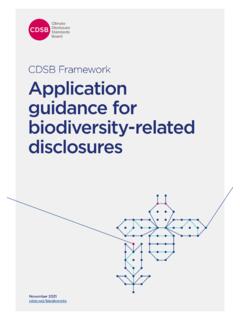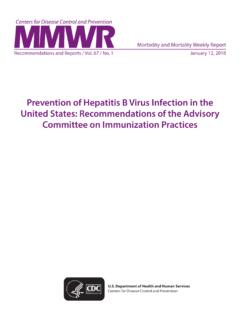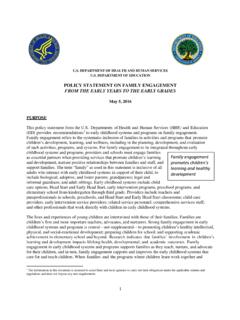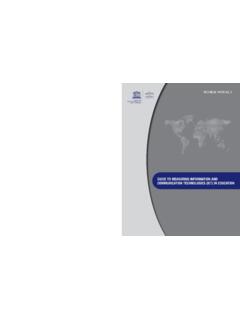Transcription of TCFD - Climate Disclosure Standards Board
1 Using SASB Standards and the CDSB Framework to Enhance Climate -Related financial Disclosures in Mainstream Reporting TCFD Implementation Guide 2019 By The SASB Foundation ( SASB ) and CDP Worldwide on behalf of the Climate Disclosure Standards Board (CDSB). All rights reserved. No liability can be accepted by SASB or The SASB Foundation, CDP Worldwide or CDSB for any claim made arising out of or in connection with the use or reliance upon the contents of this document or any part of CDSBThe Climate Disclosure Standards Board (CDSB) was founded in 2007 and is an international consortium of nine business and environmental NGOs committed to advancing and aligning the global mainstream corporate reporting model to equate natural capital with financial capital. It does so by offering companies a framework for reporting environmental and Climate information with the same rigor as financial information.
2 In turn, this helps them to provide investors with decision-useful environmental and Climate information via the mainstream corporate report, enhancing the efficient allocation of capital. Regulators also benefit from compliance-ready materials. Collectively, CDSB aims to contribute to more sustainable economic, social, and environmental SASBThe Sustainability Accounting Standards Board (SASB) connects businesses and investors on the financial impacts of sustainability. An independent, standard-setting organization founded in 2011, SASB s mission is to help businesses around the world identify, manage, and report on sustainability factors that matter to investors. SASB Standards are developed based on extensive feedback from companies, investors, and other market participants as part of a transparent, publicly documented process.
3 By focusing on the sustainability factors most likely to have financially material impacts in each of 77 industries, SASB Standards enable investors and companies to compare performance from company to company within an Plantation Place South, 60 Great Tower StreetEC3R 5AD London, UK+44 (0) 203 818 3939 Accounting Standards Board1045 Sansome Street, Suite 450 San Francisco, CA 94111 USA+1 (415) 830-9220 executive summary 2 Part I: Overview3 Introduction3 Enter the TCFD Recommendations4 SASB and CDSB: Practical Tools 6 Part II: Getting Started7 Getting Started on TCFD Implementation7 Laying the Groundwork for Effective Disclosures 11 Part III: Good-Practice Disclosures12 TCFD-Aligned Sample Disclosures16 About the Mock Disclosures17 Core Element 1: Governance23 Core Element 2: Strategy36 Core Element 3: Risk Management47 Core Element 4: Metrics & Targets56 Mock Disclosures: Key Takeaways58 Part IV: Looking Ahead59 Conclusion61 Glossary 61 Resources1 TCFD Implementation Guide Sustainability Accounting Standards Board Climate Disclosure Standards BoardExecutive summary In June 2017, the Task Force on Climate -related financial Disclosures (TCFD) issued its final recommendations for producing consistent, comparable, clear, and reliable corporate disclosures of Climate -related information that would support informed decision-making and capital allocation by investors, lenders, and insurance underwriters.
4 More than a year and a half later, although more than 617 organizations1 have publicly expressed support for the TCFD, far fewer appear to have used the recommendations to guide their Climate -related explaining this implementation gap, market participants have cited a need for practical guidance for companies to use in attempting to fulfill the principles-based recommendations and make the 11 recommended disclosures in their mainstream reports. The Sustainability Accounting Standards Board (SASB) and the Climate Disclosure Standards Board (CDSB), two well-established organizations with rigorously developed TCFD-aligned reporting tools, are uniquely positioned to provide this paper is the first in a series of practical, TCFD-focused resources CDSB and SASB intend to develop and make available in the coming months and years, as Climate -related tools and reporting practices continue to mature.
5 By offering how-to guidance, this publication aims to help companies enhance the robustness, consistency, comparability, and utility of TCFD implementation and reporting through SASB and CDSB s market-tested frameworks, Standards and of whether an organization has a sophisticated approach to managing Climate risks and opportunities or is just getting started, it can use this guidance to move forward in supporting improved decision-making, enhanced market resilience, and more sustainable economic growth. 1 as of March 2019. See The guidance adheres to the following structure: Overview: An overview of the TCFD, SASB, and CDSB, and the drive for effective corporate Climate -related disclosures; Getting Started: Key action steps to help companies lay the groundwork for effective Climate -related disclosures; Good Practice Disclosure : Sample disclosures and accompanying discussion to provide companies with a practical understanding of the four core elements of the TCFD recommendations and their specific disclosures (see Figure 1); and Looking Ahead: A summary of how the CDSB Framework and SASB Standards represent a clear solution to TCFD implementation, and areas of future 1.
6 Four core elements of the TCFD recommendationsGovernanceStrategyMetrics & TargetsRisk ManagementPart I: Overview3 Sustainability Accounting Standards Board Climate Disclosure Standards BoardTCFD Implementation Guide OVERVIEW IntroductionIn recent years, governments worldwide have rallied around coordinated efforts to meaningfully address Climate change. In 2015, the landmark Paris Agreement set the stage for global action. In December 2018, at the Conference of the Parties (COP24) in Poland, nearly 200 nations adopted a rule book to guide individual and collective actions aimed at limiting further warming of the planet, with important implications for both the public and private like these are driven partly by the potential for threats to human health, infrastructure, natural resources, energy security, and even international order.
7 However, widely-accepted Climate scenarios also present a critical economic imperative that cannot and, indeed, must not be ignored. Going green is not just a matter of saving the planet ; it is about pursuing economic growth and development that is strategic, resilient, and the concept of sustainable finance has been embraced by a growing number of market participants and policy makers,2 much work remains to be done. A 2018 Intergovernmental Panel on Climate Change (IPCC) special report on the impacts of Climate change found that if greenhouse gas (GHG) emissions continue at their current rate, the Earth s atmosphere will increase by C above pre-industrial levels by This rapidly-approaching reality far exceeds the goal supported by 184 countries in the 2015 Paris Agreement, which aims to hold the increase in global average temperature to well below 2 C above pre-industrial levels and pursu[e] efforts to limit the temperature increase to C above pre-industrial levels.
8 4 Not only is this future expected to involve potentially catastrophic impacts on agriculture, coastlines, critical ecosystems, and human poverty, it is estimated to come at a global cost of between US$54 trillion and US$69 Conversely, a coordinated global transition to a low-carbon and Climate -resilient economy is projected to involve 2 Sustainability Accounting Standards Board (SASB) and Climate Disclosure Standards Board (CDSB), Climate Risk: From Principles to Practice Phase 1 (2018).3 Intergovernmental Panel on Climate Change (IPCC), Global Warming of C An IPCC Special Report (October 8, 2018).4 United Nations, Paris Agreement (December 2015).5 According to the IPCC report (supra note 3), The mean net present value of the costs of damages from warming in 2100 for C and 2 C (including costs associated with Climate change-induced market and non-market impacts, impacts due to sea level rise, and impacts associated with large scale discontinuities) are US$54 and US$69 trillion, respectively, relative to 1961-1990.
9 Significant financial opportunities. For example, a decisive shift could yield economic gains of US$26 trillion over the next 12 years compared to a business-as-usual An ambitious global response could provide an even stronger basis for economic growth that would generate a GDP increase of around percent for the G20 on average in 2050, further increased to about percent if avoided Climate damages are accounted for. 7 The sheer scale of the challenge emphasizes the importance of harnessing the power of market forces to drive Climate action that aligns the interests of society at large with those of businesses, their investors, lenders, and insurance underwriters. The United Nations Sustainable Development Goals (SDGs) acknowledge the role of market forces. Target of SDG12 on Sustainable Consumption and Production encourages companies to adopt sustainable practices and integrate sustainable information into their reporting cycles.
10 8 Indeed, a successful global transition to a more Climate -resilient and low-carbon economy will require extraordinary financing9 far beyond what can be harnessed by governments and civil society alone. Global capital markets are therefore critical to making progress on Climate Action (SDG13) and singularly positioned to contribute to and benefit from an extraordinary but essential economic the TCFD RecommendationsRecognizing the economic risks and opportunities inherent in a changing Climate , the financial Stability Board (FSB), at the behest of the G20, established the Task Force on Climate -related financial Disclosures (TCFD) in 2015. The FSB cited the need for consistent, comparable, clear, and reliable corporate Disclosure of Climate -related information. These disclosures would support informed decision-making by investors, lenders, and insurers in allocating capital and underwriting risk.







